Seed
Seed Treatment
Before planting, dip stones in solution of Dimethoate for few minutes. It will protect crop from mango weevils. Seed treatment with Captan fungicide will help to protect seeds from fungal infections.
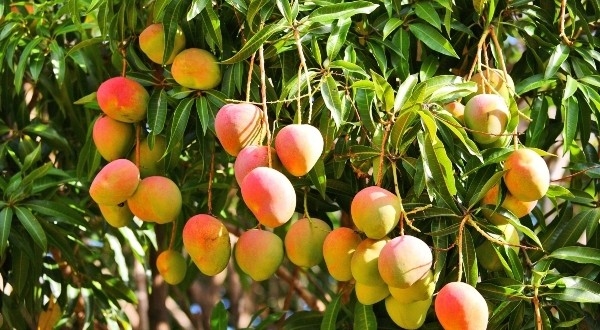
Seed Treatment
Before planting, dip stones in solution of Dimethoate for few minutes. It will protect crop from mango weevils. Seed treatment with Captan fungicide will help to protect seeds from fungal infections.
Light irrigation is given immediately after seed sowing. Then next irrigation is given immediately after transplanting, and then later irrigation is given when requires. In arid and semi-arid regions irrigation is required at proper intervals.
For good yield of crop, weeding must be done at proper intervals. Earthing up after 2-3 weeks of transplanting will help to remove weeds from the fields. First weeding is done after 30 days of transplanting then second weeding is done after 60 days of transplanting.
Fertilizer Requirement (gm/tree)
|
Age of crop (Year) |
FYM (in kg) |
Urea (gm/tree) |
SSP (gm/tree) |
MOP (gm/tree) |
| First to three year | 5-20 | 100-200 | 250-500 | 175-350 |
| Four to six year | 25-50 | 200-400 | 500-750 | 350-700 |
| Seven to nine year | 60-90 | 400-500 | 750-1000 | 700-1000 |
| Ten and above | 100 | 500 | 1000 | 1000 |
Nutrients Value (gm/tree)
| NITROGEN | PHOSPHORUS | POTASH |
| 27 | 7 | 30 |
Mango crop required 27 kg of N, P2O5 about 7 kg and 30 kg of K2O per acre. For crop of 1-3 year old, Apply 5 to 20 kg of well decomposed cow dung, 100-200 gm of urea, 250-500 gm of Single super Phosphate and 175-350 gm of MOP per Tree. For 4-6 year old crop apply increased cow dung dose by 25 kg, give urea@400-500 gm, SSP@500-750gm and MOP@350-700 gm per Tree.
For 7-9 year old crop, apply 60-90 kg of well decomposed cow dung, urea @800-1000 gm, SSP@750-1000 gm, MOP@700-1000 gm per tree. For 10 year or above 10 year crop, apply 100 kg of well decomposed cow dung, urea @1000 gm, SSP@1000 gm and MOP@1000 gm per Tree.
Give N and K dose of fertilizer in February month whereas apply whole amount of cow dung and SSP in December month.
Sometime changing weather causes fruit and inflorescence drop. If fruit dropping is observed to minimize it spray 13:00:45@10gm/Ltr of water. Use mulching to minimize temperature effect. For good flowering and yield, spray 00:52:34 @150gm/15Ltr of water twice at 8 days interval when flowering starts. It will prevent flower drop also.
It is the most important fruit of Haryana. Panchkula, Ambala, Kaithal, Karnal, Kurukshetra, Sonepat, Yamunanagar and Jind are major crop growing areas. Because of agro climatic conditions in Haryana, Mango crop is suitable for cultivation. Mango is rich source of Vitamin A and C; its leaves are used as fodder in case of shortage of fodder while wood is used for furniture making. Unripen fruits are used for chutney, pickles and ripe fruits are used for eating purpose as well as for syrups, jam and jelly.
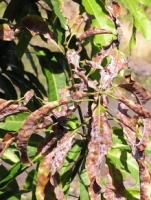
Powdery Mildew: Whitish powdery growth observed on inflorescence and the floral parts. In severe condition, they get drop. Also fruits, branches and floral part show dieback symptoms.
Before flowering, during flowering and after fruit set, take spray of 1.25kg wettable sulphur in 200 litre of water. If needed, take second spray with interval of 10-15 days. If infestation is observed in field, take spray of 178% Imidacloprid@3ml along with Hexaconzole@10ml/10Ltr water or Tridemorph@5ml or Carbendazim @20gm/10Ltr of water.




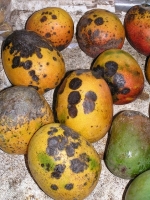
Anthracnose or Dieback: Dark brown or black spots are observed on shoots. On fruits also small, raise, dark spots are observed.
To control dieback and other diseases, cut infested, dead portion and apply bordo paste on it. Spray Bordeaux mixture@10gm/ltr of water. If infestation observed in field take spray of Copper oxychloride@30gm/10Ltr on infected trees. If Anthracnose observed on new flush. Spray with Thiophanate methyl@10gm or Carbendazim@10gm/10Ltr of water.




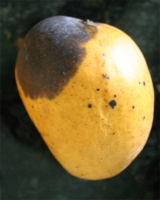
Black Tip: Fruits get abnormally elongated at tips along with pre-mature ripening of fruits.
Before flowering, during flowering take spray of Borax@6gm/ltr of water + Copper Oxychloride@3gm/Ltr of water for three times with 10-15 days interval.




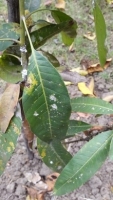
Mealy Bug: It causes damage to crop by sucking sap from inflorescences, stem, leaves and shoot. Infestation observed mostly in January to April. Mealy bug affected part dried and sooty mould is seen on infected parts.
To prevent tree from mealy bug infestation, 25 cm width Polythene (400 gauge) strip fastened around tree trunk to stop ascent of nymphs before hatching of eggs in month of Nov and Dec. If infestation is observed, spray with Acephate@2gm/Ltr or Spirotetramat@3ml/Ltr of water is done to cure from mealy bug.




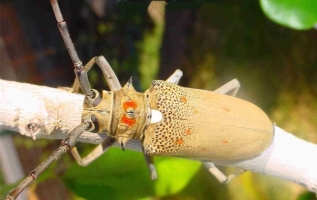
Mango Hopper: Infestation is observed mostly in February-March Month when crop is in flowering stage. They suck sap from inflorescences, leaves. On infection flower get sticky and sooty mould a black color fungus is developed on affected parts.
If infestation is observed take spray Cypermethrin 25EC @3ml or Deltamethrin 28EC@9ml or Fenvelarate20EC@5ml or Nimbecidine 1000ppm@20ml in 10Ltr water on whole tree.
High fertile soil with god drainage system is recommended best for mango cultivation. Avoid cultivation in saline and halocline soil as it is unsafe for mango plantation. pH of soil should be less than 8.5%.
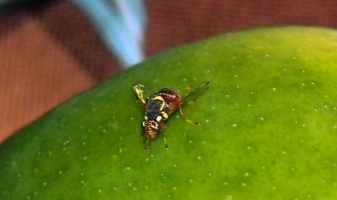
Mango Fruit Fly: It is serious pest of mango. Females lay eggs below epidermis of young fruits. Later on maggots feed on pulp afterward fruits starts rotting and get drop.
Destroy infected fruits away from field. During fruit developed stage, hang traps of 100 ml emulsion of methyl Eugenol 0.1%. In May month start spraying of Chlorpyriphos 20EC@2ml/ltr of water for three time with interval of 20 days.
Dusheri: It is widely grown in a region. Fruits are ready to harvest in first week of July. Fruits are small to medium size, smooth having yellow color, sweet in test and stone is of small size. The fruits of this variety have better keeping quality. It is regular bearing crop. It gives average yield of 150 kg fruits per tree.
Langra: Fruits are medium to large, smooth having lemon yellow color. Flesh is fibreless with fine test. Skin of fruit is medium thick. Fruits are ready to harvest in second week of July. It gives average yield of 100 kg per plant.
Malika: It is a cross between Neelam and Dushehri varieties. It bears regular fruits.
Amarpali: It is a cross between Neelam and Dushehri varieties. It also bears regular fruits. The variety has small sized plant.
Bombay Green: This variety has medium size plant, smooth skin, fibreless flesh which is soft, juicy and sweet pleasant taste. The fruits get ripens in the month of July.
Fazli: It has large size, medium thick skin which is green in color, pleasantly flavored and sweet flesh. The fruits get ripens in the month of August.
Sepia Shahpasand: It is a mid-season cultivator. It has medium sized fruit which is lemon green in color. Fruits are juicy, seet in flavor and mildly aromatic.
Other state varieties:
Hybrids: Mallika, Amrapali, Ratna, ArkaArjun, ArkaPuneet, ArkaAnmol, Sindhu, Manjeera
Varieties: Alphonso, Bombay Green, Dashahari, Himsagar, Kesar, Neelum, Chausa.
Alphonso: Having great export potential. Fruits are of medium and oval size. Fruits are of greenish light yellow with light pinkish blush. Flesh is fibre free with superb test. Skin of fruit is thin and smooth. Fruits mature in first week of July.
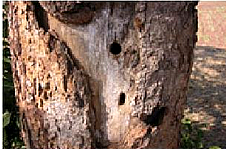
Stem Borer: Serious pest of mango crop. It creates tunnel under bark and destroyed tree by feeding on internal tissue. Larva of stem borer excreta is observed outside of tunnel.
If infestation is observed, clean tunnel with hard wire and insert cotton swab dip in mixture of Kerosene and Chlorpyriphos in ratio of 50:50. Then closed it with mud.
Do ploughing, cross ploughing of land and then leveled the land. Prepare land in such way that water stagnation should not occurred in field. After levelling take one deeper ploughing and then divide lands in blocks. Spacing is varied from place to place.
Changing of fruit color is sign of fruit maturity. It usually required 15-16 week after fruits set to get mature. Pick individual fruits with help of ladder or bamboo having sharp knife and having net to collect harvested fruits. Avoid falling of fruits on ground as it will damage fruits during storage. After harvesting, do sorting and grading of fruits according to size, color and then packed in boxes. Place harvested fruits on polynet upside down.
Time of sowing
Planting is done in month of August-September also in February - March. Do planting in cool hours of evening. Protect crop from high wind.
Spacing
For grafted varieties use distance of 9x9 metre and plant them in square system.
Sowing Depth
Dug pits of 1x1x1m size at distance of 9x9m one month earlier before planting. Expose them to sun. Fill with mixture of soil, 30 to 40 kg of FYM or Compost and 1 kg single super phosphate.
Method of sowing
Square and hexagonal planting can be adopted. Hexagonal planting accommodates 15% more plants.
After harvesting dip fruits in water. Reject immature fruits which float on water. After that place fruits in 25 gm/Ltr salt water. Fruits which float in salt water are used for export. According to prevention of Food adulteration act (1954) ripening of any food by using Carbide gas is a crime. For uniform ripening of fruits , dip 100 kg fruits in 100 Ltr of water containing (62.5 ml-187.5 ml) Ethrel at 52 ± 2°C for 5 min within 4-8 days after harvesting. For fruit fly detection in export quality fruits VHT (vapor heat treatment) is compulsory. For this process use 3 days prior harvested fruits.
You have successfully login.
Your email and password is incorrect!